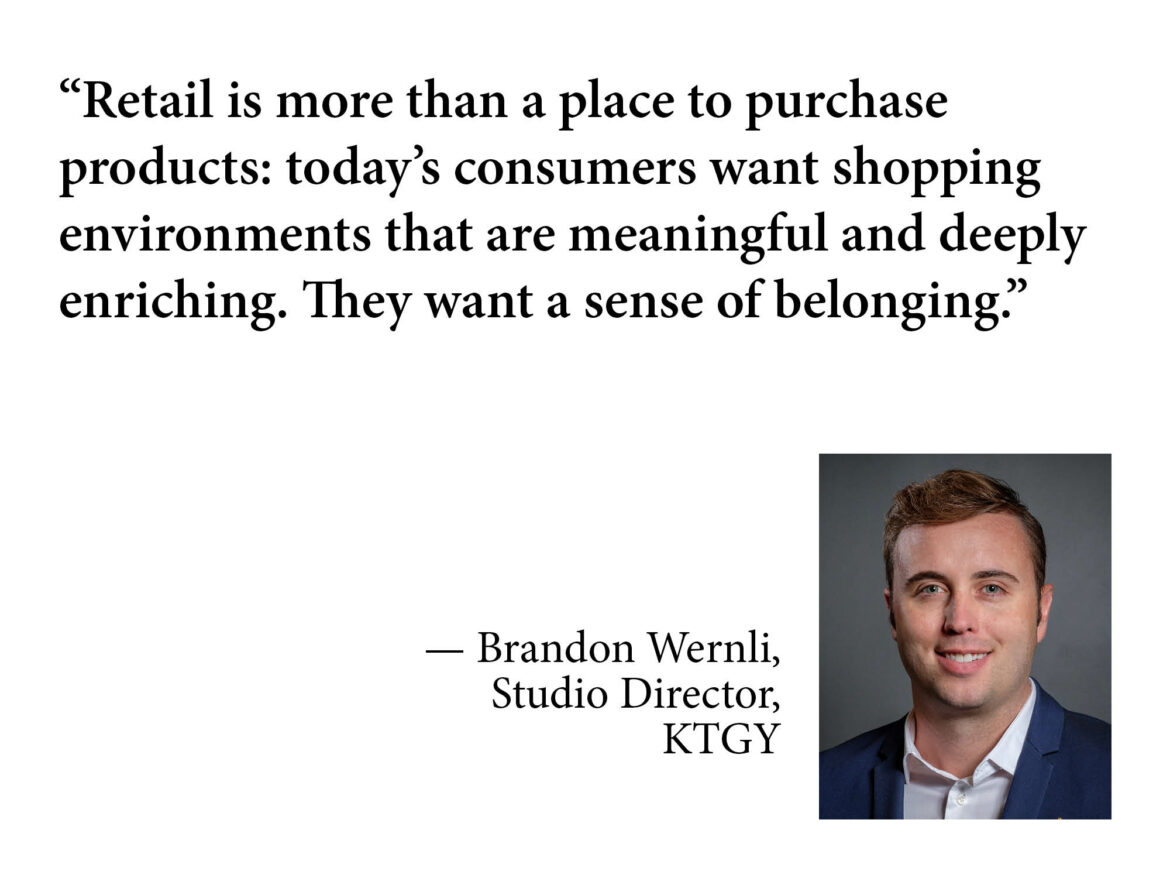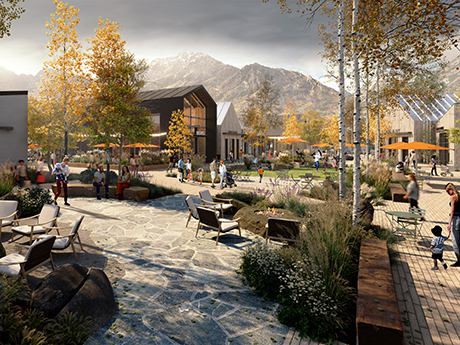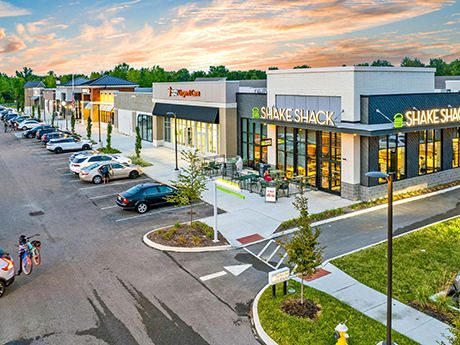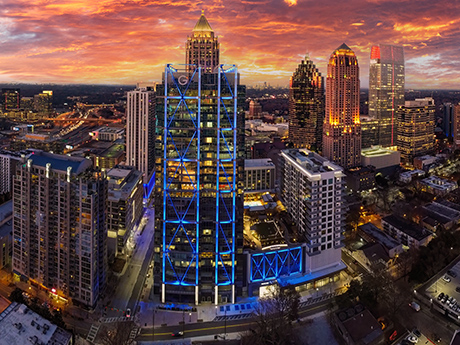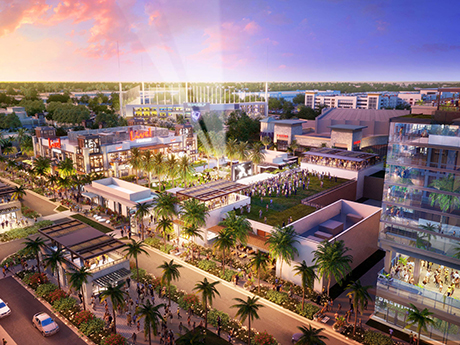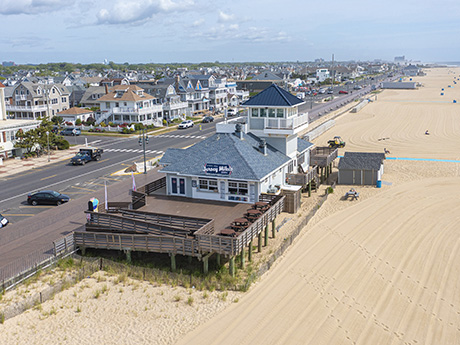When Chinese collectible toy phenomenon Pop Mart opened its 24th U.S. location at the Galleria Dallas mall last spring, social media vloggers documented hundreds of fanatic shoppers arriving the night before and then inching their way through retractable belt stanchions the next day to finally enter the store and purchase coveted Labubu collectibles. Pop Mart’s reception in Dallas may be over the top compared to the more standard welcome that other international brands receive in the United States, but foreign retailers and food-and-beverage operators are nevertheless discovering enthusiastic U.S. shopper …
Features
Retail is the Catalyst for Belonging
By Brandon Wernli, studio director at KTGY The time we live in is marked by a profound transformation in how people work, live and connect with each other. Since 2020, shopping centers, regional malls, commercial plazas and lifestyle districts have reasserted themselves as more than places of financial transaction; they are a social necessity. We are living through a societal shift away from the postwar model of expansive single-family homes and isolated retail strips. Reversing decades of suburban sprawl, the residences built today are reducing lot sizes and favoring connectedness …
With placemaking, flexibility and the ever-changing needs of retailers and consumers in mind, retail architects are more creative than ever when it comes to built environments. Retail spaces have changed dramatically over the past decade. Enclosed environments, once leading the trend in the industry, have been traded for open-air environments. Many properties that were once solely occupied by retail tenants now have multiple uses, including entertainment, office, multifamily and hotel. In a time when it’s tough to develop, smaller, convenience-oriented projects are dominant, with the redevelopment of regional properties a …
All types of purchasers, from private capital to institutional groups, want to take advantage of the property sector’s strong fundamentals. In JLL’s second-quarter “Retail Market Dynamics” report, “resilience” was the word used to describe the national retail investment landscape in the first half of 2025. Transaction volume reached $28.5 billion, a 23 percent increase over the same period a year ago. The figure also outpaces the long-term historical average of $27.7 billion for the first two quarters of the year, according to the brokerage firm. The scope of data includes …
Owners of struggling shopping malls should prepare to demonstrate how changed consumer preferences and practices reduce taxable property value. A great deal has changed in the real estate world since the COVID-19 pandemic. Of the many types of real estate holdings affected, shopping malls anchored by one or more large department stores have suffered more than most. The buying public is simply less inclined to frequent such properties than in the past, draining much of the functionality, revenue potential and market value from those assets. As a result, the taxable …
Landlords need to take an active role as troubled retailers face bankruptcy. The old playbook of waiting to address leases in bankruptcy is over. In today’s environment, where chainwide liquidation is becoming an increasingly common outcome, landlords cannot afford to be passive. It is crucial to proactively engage with tenants, understand their financial health, and be prepared to negotiate and adapt lease terms to help them avoid bankruptcy court. Consider what has happened in American retailing since the pandemic. While some sectors thrived during the initial COVID-19 lockdowns and the …
Atlanta’s next retail boom is being driven by Millennial demand. Developers and investors are witnessing a trend that Atlanta retail activity is quickly expanding to its outer suburbs, fueling a new chapter of growth for the market. “There’s a lot of momentum and growth happening, not just in the city of Atlanta, but when you really start looking at the MSA as a whole,” says Michael Berk, vice president of SRS Real Estate Partners. “The thing about Georgia and Atlanta is there’s no natural boundary that will inhibit growth.” Berk …
Florida’s retail sector continues to thrive due to sustained economic success, with traditional developments filling the gaps around the state. When asked what makes Florida appealing from a retail perspective, Steven Miskew, CEO of Southeast Centers, put it succinctly: “The good macro-economic drivers are here: population growth, lack of supply and low vacancy, all in a pro-business environment.” As Miskew asserts, Florida’s population continues to swell as approximately 1,755 people move into the state daily, according to 2023 data from online self-storage platform StorageCafe. Additionally, U-Haul has ranked Florida as …
Retail-to-restaurant conversions have proven to be a profitable real estate strategy for Golden Corral. The rising costs of new development present an opportunity for retail and restaurant brands to rethink their expansion strategies. One of the most effective ways to fuel growth while mitigating high development costs is by repurposing second-generation spaces — previously occupied retail locations — into thriving restaurant concepts. Golden Corral is leading the charge, targeting these spaces as prime opportunities for conversion and rapid expansion. Why Second-Generation Retail Spaces Work for Restaurants The retail sector is …
How QSRs are powering the rise of hyper-local retail real estate. The quick service restaurant (QSR) industry is reshaping retail real estate by capitalizing on the “15-minute city” trend — a movement where people can access essentials within a short walk, bike ride, or delivery window from home. This shift, fueled by evolving consumer behavior, urban densification, and the rise of digital ordering, is pushing QSRs to prioritize hyper-local presence over traditional highway or regional hubs. The result is a transformation in both real estate development and the metrics that …



